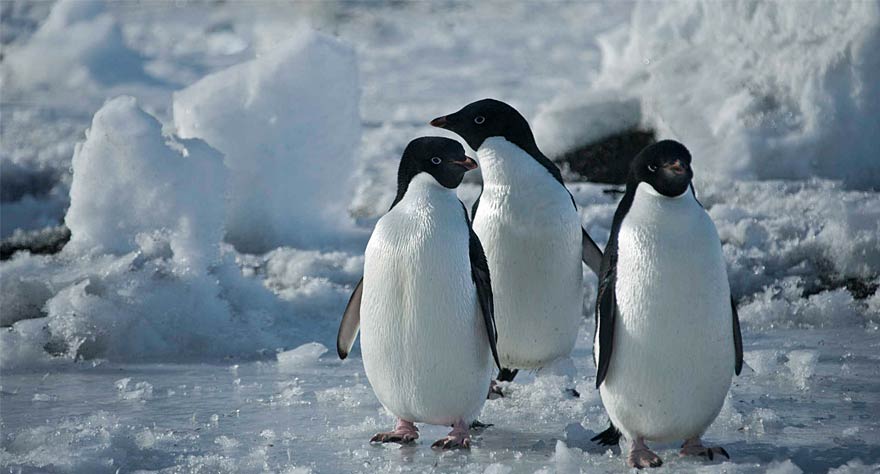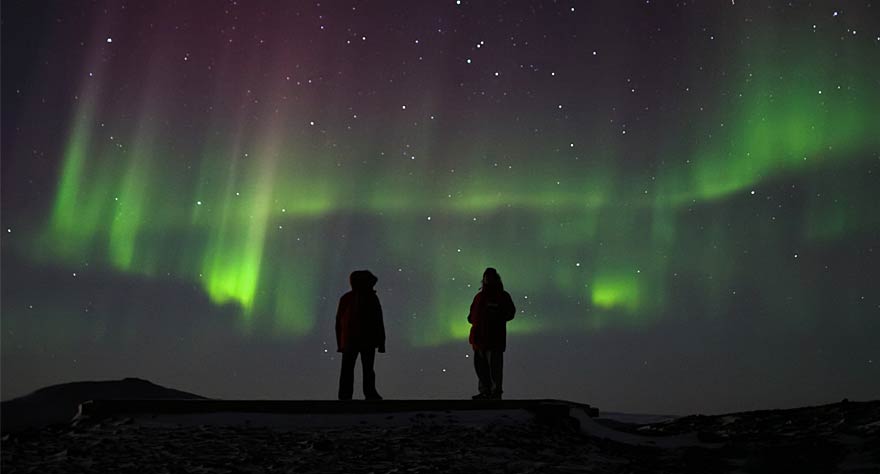
Despite its joyous visuals, the absence of any narrative cripples the film.

Despite its joyous visuals, the absence of any narrative cripples the film.
Because I grew up near Philadelphia, a tradition of my youth involved the annual class trip to the Franklin Institute and its Tuttleman IMAX theater. These were the days before IMAX became just another option at the local cineplex, and the days when the only films being made in the large format were mostly documentary-style films that showcased nature in one form or another, whether atop a mountain, beneath an ocean, or anywhere in between. There were no plots nor players in those films—only stunning photography and plenty of it. I was reminded of those films by Antarctica: A Year on Ice, a documentary from first-time director Anthony Powell.
The New Zealander is a self-taught photographer who works at a base in Antarctica, and using camera equipment he designed and constructed on his own (to withstand the region’s brutal cold), Powell filmed everyday activities and every conceivable weather condition on the continent over a 10-year period to assemble and present what an average year in the life of Antarctica is like. Summers are cold and the sun doesn’t set for months on end. Winters are excruciating and the sun doesn’t rise for more months. Storms howl. Silence conquers even the sharpest of ears. Nature is observed and it does some observing of its own.
As for the residents of the bottom of the planet, there is a great camaraderie among them (5,000 strong in summer, 700 in winter); in fact, Powell met and married his wife there. Yet there is also a painful loneliness for those who normally call another country home. While these people get to witness first-hand the splendor of their environs, they are also missing births, deaths, and other life events back home. Powell has been there to capture it all.
Dazzling. Grand. Majestic. Breathtaking. Every go-to adjective reserved for a large-scale “nature film” applies to Antarctica: A Year on Ice, and the wonder of nature that Powell captures cannot be overstated. On land, at sea, and in the air, Powell’s cameras offer views of nature’s most striking extremities: from the serenity of a nighttime sky filled with more stars than a Christopher Nolan blockbuster, to the punishing violence of storms blending the might of hurricanes with the ferocity of blizzards, and every animal, mineral, and temperature in between. Some of those stunning views are presented as they happen real-time, while others are beautifully manipulated by Powell’s deftness with time-lapse photography. The rookie director is also a terrific cinematographer, especially considering he made much of his own equipment.
Yet for the joyous visuals Antarctica: A Year on Ice offers, the absence of any narrative simply cripples the film.

Unlike older observation-only films, this film has woven throughout nature’s money shots a collection of interviews with the denizens of the snowbound bases, all of whom offer many anecdotes but very little substance. They are people who, while surely charming in real life, are better identified by their roles there—cook, store clerk, engineer, etc.—than by any name or trait. The information they offer (with maybe a few exceptions) very much feels like Powell set up a camera, rolled film, and said, “Okay, tell us a story … now some thoughts … now something else … whatever comes to mind … and what else do you have …,” and so on until he had enough stories to integrate into his nature footage.
At a higher level, though, this film is supposed to document what it’s like to live in a place that, in winter, is completely isolated from the rest of the world for months on end. There are no daily charters round-tripping the place; one either leaves before winter hammers down or survives the brutal season, come what may. The film never holds up that end of the bargain.
Sure, weather and solitude play a big part, but no other depths about life there are truly plumbed. Powell’s inability/unwillingness to detail this is evident early when, while onscreen and trudging through the cold, he jokes about not confusing his water bottle with his pee bottle. The first two questions that spring to mind: Why do you need a pee bottle? How do you pee outside when it’s that cold? The questions are never asked nor answered. The film is full of moments like this – moments that are unique to living there and that warrant a mention, but then are not expanded upon. Even worse is the absence of basic interests that are never considered at all. What’s the protocol if someone dies there and the body can’t “go home” for months? Are there rules against fraternizing with others? If so, how do people cope with their sexual urges? How is health managed? What if someone’s glasses break?
The fact that these types of questions are never asked or answered is a direct byproduct of the fact the film was made by a resident, not a documentarian. Powell, over the course of 10 years of living there, has become so immersed in the life that he has no sense of what would be curious to an outsider. He’s not to blame for this, but his film suffers as a result of it.
Based on the might of its visuals alone, Antarctica: A Year on Ice is worth every one of its 91 minutes. However, once Mother Nature gives ’em the old razzle dazzle, the film winds up being nothing more than the most breathtaking home movie in history.